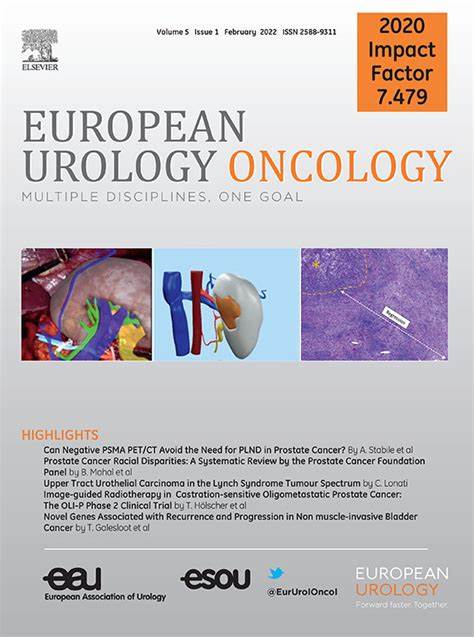前列腺癌诊断后服用复合维生素与较低的复发风险相关:一项来自前列腺癌战略泌尿学研究努力(CaPSURE)的前瞻性队列研究。
IF 9.3
1区 医学
Q1 ONCOLOGY
引用次数: 0
摘要
背景与目的:复合维生素(MV)在前列腺癌(PC)患者中很常见。然而,MV使用与PC复发风险的关系数据有限。方法:我们对1396名接受根治性前列腺切除术(RP)或放射治疗(RT)的非转移性PC患者进行了纵向观察队列研究,这些患者在1999年至2018年期间参加了前列腺癌战略泌尿研究努力(CaPSURE)研究。主要终点为PC复发,定义为生化复发或开始二次治疗。在诊断后和复发前通过问卷调查确定诊断后MV的使用。多变量Cox比例风险回归模型控制了社会人口因素、临床因素和健康行为,并用于计算调整后的风险比(hr)和95%置信区间(ci)。主要发现和局限性:在研究队列中,有858名(62%)当前的MV用户,227名(16%)过去的MV用户,311名(22%)从未使用过MV。我们观察到119例PC复发事件,在调查完成后的中位随访时间为4.7年(四分位数间隔为1.9-9.2年)。目前使用MV与较低的PC复发风险相关(基本模型:HR 0.52, 95% CI 0.35-0.78;调整模型:HR 0.51, 95% CI 0.33-0.78)。在分层分析中,对于2级组(Gleason 3 + 4)或更高PC的男性,目前MV使用与PC复发之间的负相关更强(n = 430;Hr 0.27, 95% ci 0.13-0.55;结论和临床意义:PC诊断后使用MV与较低的PC复发风险相关,特别是在疾病级别较高的患者中。这一发现值得证实和进一步调查。本文章由计算机程序翻译,如有差异,请以英文原文为准。
Multivitamin Use After Prostate Cancer Diagnosis Is Associated with Lower Risk of Recurrence: A Prospective Cohort Study from the Cancer of the Prostate Strategic Urologic Research Endeavor (CaPSURE)
Background and objective
Multivitamin (MV) use is common among men with prostate cancer (PC). However, data on MV use in relation to the risk of PC recurrence are limited.
Methods
We conducted a longitudinal observational cohort study in 1396 men with nonmetastatic PC who underwent radical prostatectomy (RP) or radiation therapy (RT) and enrolled in the Cancer of the Prostate Strategic Urologic Research Endeavor (CaPSURE) study between 1999 and 2018. The primary outcome was PC recurrence, defined as biochemical recurrence or initiation of secondary treatment. Postdiagnostic MV use was ascertained via a questionnaire after diagnosis and before any recurrence. Multivariable Cox proportional-hazards regression models controlled for sociodemographic factors, clinical factors, and health behaviors and were used to calculate adjusted hazards ratios (HRs) and 95% confidence intervals (CIs).
Key findings and limitations
In the study cohort there were 858 (62%) current MV users, 227 (16%) past MV users, and 311 (22%) never users. We observed 119 PC recurrence events over a median follow-up of 4.7 (interquartile range 1.9–9.2) yrs after survey completion. Current MV use was associated with lower risk of PC recurrence (basic model: HR 0.52, 95% CI 0.35–0.78; adjusted model: HR 0.51, 95% CI 0.33–0.78). In stratified analyses, the inverse association between current MV use and PC recurrence was stronger for men with grade group 2 (Gleason 3 + 4) or greater PC (n = 430; HR 0.27, 95% CI 0.13–0.55; p < 0.001) and was not statistically significant for men with grade group 1 (Gleason 3 + 3) PC (n = 966).
Conclusions and clinical implications
MV use after PC diagnosis was associated with lower risk of PC recurrence, particularly in patients with higher-grade disease. This finding warrants validation and further investigation.
求助全文
通过发布文献求助,成功后即可免费获取论文全文。
去求助
来源期刊

European urology oncology
Multiple-
CiteScore
15.50
自引率
2.40%
发文量
128
审稿时长
20 days
期刊介绍:
Journal Name: European Urology Oncology
Affiliation: Official Journal of the European Association of Urology
Focus:
First official publication of the EAU fully devoted to the study of genitourinary malignancies
Aims to deliver high-quality research
Content:
Includes original articles, opinion piece editorials, and invited reviews
Covers clinical, basic, and translational research
Publication Frequency: Six times a year in electronic format
 求助内容:
求助内容: 应助结果提醒方式:
应助结果提醒方式:


